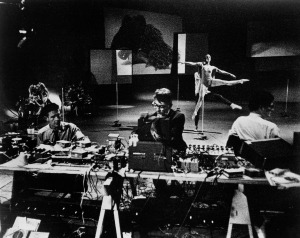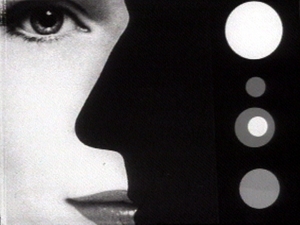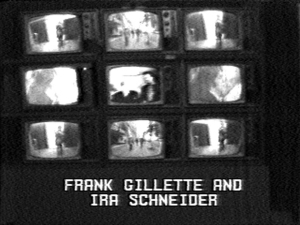|
dorkbot-sea, in collaboration
with CoCA
and Seattle
Art Museum present 1960’s Electric Arts: From
Kinetic Sculpture to Media Environments, a film screening
of incredible original archive film and video footage of the
first artists to work with technologies that we consider ‘modern’
today: infra-red cameras, contact microphones, television, sensors
and beyond.
Seattle-based, internationally-recognized media arts consultant,
historian and curator Robin Oppenheimer curates and introduces
an evening of excerpts from films showing artists such as Robert
Rauschenberg, Jean Tinguely, Merce Cunningham, John Cage and
the collective USCO, in collaboration with engineers such as
Billy Kluver, both creating, exhibiting and performing work
that is radical in scope and execution even today.
Robin has collected these films especially for this event. The
vast majority have never before been seen in Seattle - and are
simply never seen by the public in general. Don’t miss
this unique opportunity!
The film screening will be held at Seattle
Art Museum Downtown in their Pletscheeff Auditorium
on Wednesday March 2nd.
ADMISSION IS FREE, $5 suggested donation.
DJ Ez-Action spins rare 1960’s exotica, yé-yé
and lounge from 7:00 pm in the SAM Lobby, with visuals from
VJ Scobot,
taking you on a time-travel trip before the screening starts.
Screening begins at 7.30pm.
More
info about the screening.
Directions to SAM.
PRESS:
Art
Dish
Seattle
Times Critics’ Picks (requires registration)
Seattle
Weekly
See our press release here.
Robin Oppenheimer has written
this essay to
accompany the screening.
|

| Merce
Cunningham and Dance Company, Variations V. Photo by Herve
Gloauguen |

| Stan VanDerBeek.
“Visibles,” 1959-1972. Courtesy Electronic Arts
Intermix (EAI), NY. |

| Ira Schneider.
“TV as a Creative Medium,” 1969-1984. Courtesy
Electronic Arts Intermix (EAI), NY. |
|
|
Homage to Jean Tinguely's "Homage to New York"
(1960), 9.5 min. 16mm, b&w
Filmmaker: Robert Breer
"This tribute is an expressionist documentary of Swiss
motion sculptor Jean Tinguely's auto-destructive sculpture as
it is assembled and then self-destructs at The Museum of Modern
Art. Tinguely's sculpture is an eclectic, massive conglomeration
of wheels, bathtubs, piano strings, pulleys, and airplane parts
that are constantly in motion. Breer overlays segments of the
Homage being set on fire with scenes of the original drawing
plan and welding, and extends his portrait by manipulating his
imagery in kinetic collages which reflect the energy of Tinguely's
work." (MoMA Circulating Film Library Catalogue)
USCO at the Church
(1960s) 16 min. excerpt, 16mm, color
Cinematography by Jud Yalkut (USCO member)
Narration by Gerd Stern (USCO founder and member)
Music by Harry Partch
USCO at the Church is a documentation of several aspects of
the USCO (US Company) collective. It features one of their multimedia
installations, including the dismantling of all the equipment
afterwards by the group that included a young Stewart Brand
(Whole Earth Catalogue publisher). Also shown are numerous USCO
electrical sculpture pieces being packed for shipping to Europe,
and the construction and erection of a parachute ceiling/screen
inside the tabernacle where they lived in Garnerville, NY.
Variations V
(1966), 50 min. 16mm, b&w
Choreography by Merce Cunningham
Music by John Cage, assisted by Gordon Mumma and David Tudor
Distortion of TV images by Nam June Paik
Film images by Stan Vanderbeek
Engineers: Billy Kluver, Cecil Coker, Witt Wittnebert
Produced by Studio Hamburg, Nordeutscher Rundfunk
Dancers: Carolyn Brown, Merce Cunningham, Barbara Lloyd, Sandra
Neels, Albert Reid, Peter Saul,
Gus Solomons, Jr.
"'Variations V' is a multi-media work involving sound sensitive
electronic poles placed around the stage. The sound is triggered
by the dancer's movements and then altered or delayed by the
musicians. Filmmaker Stan Vanderbeek recorded rehearsals of
the dancers and then overlayed this footage as well as other
stock footage images in the final film. Composer Nam June Paik
projected these images on television screens during the performance.
Non-dance related activities were also performed. Merce Cunningham
potted a large plant and Carolyn Brown repotted it. The plant
had a microphone attached to it so that any movement would produce
sound. At the end of the piece, Merce Cunningham rode a bicycle
through the space." (www.merce.org/filmvideo_archival.html)
Stan Vanderbeek
Excerpts from two Camera 3 television documentaries about Stan
Vanderbeek
Stan Vanderbeekiana (1968, Nick Havinga, 28 min.)
and The Computer Generation!! (1972, John Musilli, 28 min.).
Stan Vanderbeek was born in 1927 and died in 1984. "His
early collage animation was created in the spirit of the Surrealist
and Dadaist work of Max Ernst, but with a wild, rough informality
more akin to the expressionism of the Beat Generation…
A pioneer in the development of experimental film and live-action
animation technique, Vanderbeek achieved widespread recognition
in the American avant-garde cinema. An advocate of the application
of a utopian fusion of art and technology, he began making films
in 1955. In the 1960s, he produced theatrical, multimedia pieces
and computer animation, often working in collaboration with
Bell Telephone Laboratories. In the 1970s, he constructed a
'Movie-Drome' in Stony Point, New York, which was an audiovisual
laboratory for the projection of film, dance, magic theater,
sound and other visual effects. His multimedia experiments included
movie murals, projection systems, planetarium events and the
exploration of early computer graphics and image-processing
systems." (www.eai.org)
TV as a Creative Medium
by Ira Schneider
(1969-84), video, 12:08 min., b&w, sound
"In May of 1969, the Howard Wise Gallery in New York presented
'TV as a Creative Medium,' the first exhibition in the U.S.
devoted entirely to video as a form of art. Schneider recorded
this historical document of the landmark exhibition. It features
works such as Nam June Paik's 'Participation TV,' Paul Ryan's
'Everyman's Mobius Strip,' Thomas Tadlock's 'Archetron,' Eric
Siegel's 'Psychedelevision in Color,' Charlotte Moorman's first
performance of Paik's 'TV Bra For Living Sculpture,' and Schneider's
own collaboration with Frank Gillette on the installation 'Wipe
Cycle.'" (www.eai.org)
About Robin Oppenheimer: Robin Oppenheimer is an internationally-recognized
media arts consultant, historian, curator, writer, and educator
who has worked in the field since 1980. Clients include the
University of Washington, Seattle Public Schools, City of Seattle,
Museum of Glass, and Bellevue Art Museum. She is also a former
Executive Director of 911 Media Arts Center in Seattle, and
IMAGE Film/Video Center in Atlanta, where she directed the Atlanta
Film & Video Festival. You can contact Robin at robinopp
AT nwlink dot com.
|